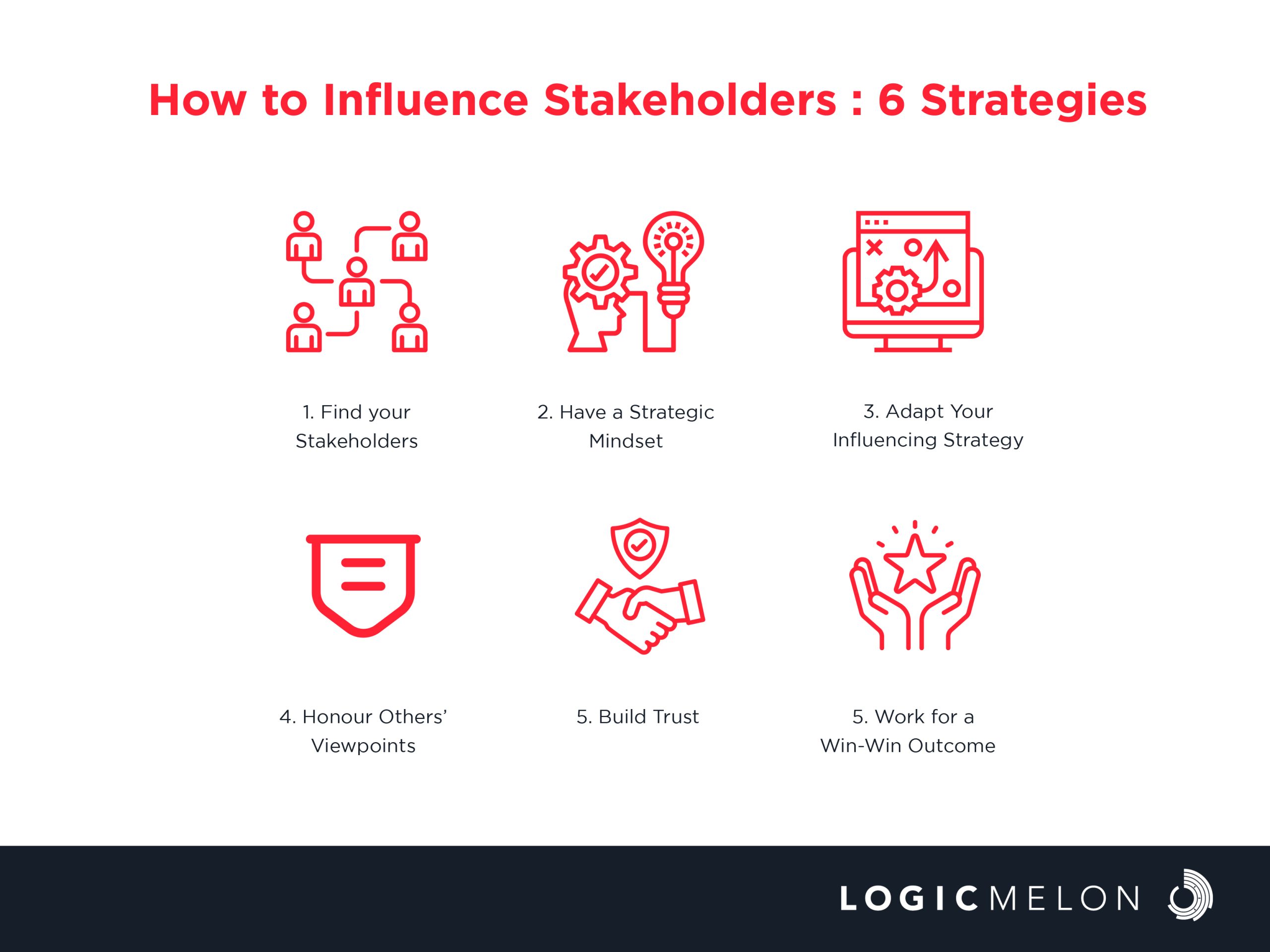6 Strategies on How to Influence Stakeholders
Effective leadership requires the ability to influence stakeholders. The capacity to influence stakeholders is one of the most effective qualities a business analyst should have. The long-term goal will be easier to achieve for people who possess the ability to influence others than for those who do not. The advantage of being an influencer goes far beyond interactions with other professionals and may successfully apply to life events.
So, how can you overcome stakeholders’ opposition or fears and convince them to accept the change? Here are some quick strategies that can help you how to influence stakeholders to get what you want:
How to Influence Stakeholders: 6 Strategies

1. Find your Stakeholders
The first step is identifying your stakeholders and understanding their needs, wants, and motivations. Do not just include the important people in the industry on your list. Also, do not forget to include the key players who can help you gain access to the information you need to prove your point or open doors. Make a list of all your key stakeholders and try to rank them in order of how important they are to the project’s success. Based on their level of influence and interest, you can categorise them using a stakeholder analysis tool, such as a matrix or a map. Doing this will help you prioritise your communication and engagement tactics.
2. Have a Strategic Mindset
After having a clear understanding of the stakeholder, you should begin preparing your communication strategy and relationship-building tactics. Stakeholder engagement cannot be left to chance or one person if you are working on a project that is important to the future of the company. Everyone on the project team must assume responsibility for ensuring that the proper individuals are contacted, informed, and involved. Create a schedule for ongoing communication with all the relevant parties, carefully considering the level of communication that each will require, how frequently you must interact with them to keep the momentum going, and the techniques or channels you will employ.
3. Adapt Your Influencing Strategy
Everyone has a preferred influencing strategy. Maybe you prefer to concentrate on providing the data and facts to support a strong business case. Or perhaps you prefer to create excitement and energy by narrating stories and presenting hypothetical future scenarios. At any rate, it is vital to understand that those you are trying to influence will have their own preferences for how they prefer to take in and absorb information.
Some people will demand a formal presentation with all the key points listed in black and white, along with the advantages and disadvantages. Others may prefer a more conversational approach and might want to discuss the consequences informally before taking some time to consider their responses. The best influencers can use a toolkit of influencing strategies and tactics, spot clues about how to convey their message most effectively and change their delivery method to fit the audience and the situation.
4. Honour Others’ Viewpoints
Take a step back and imagine yourself in other people’s situations. Even if you see how the planned initiative will benefit the company, others might not agree. Consider how the new effort or planned change will impact the stakeholders you need to involve. How will it affect the way they approach their work? What worries are they likely to have regarding their roles and the structure and methods of operation of their teams? It is more effective to have open discussions about their concerns than to try to subdue them. Ask lots of questions and pay attention to what others are saying. These open discussions will help you develop trust and generate concepts and insights that will ultimately result in a better solution.
5. Build Trust
Trust is necessary to influence stakeholders. Must build and maintain a trustworthy connection with them based on decency, reliability, and credibility. You can do this by acting and communicating in an open, genuine, and respectful manner. You may also express appreciation, empathy, and recognition for their needs, goals, and accomplishments. Can promote an atmosphere of openness, collaboration, and support for change by developing trust.
6. Work for a Win-Win Outcome
It is not always possible to get exactly what you want in business. Yet, if you can find a means to create mutual benefit, your project or change program has a better chance of succeeding. Find out what motivates your coworkers’ objectives and the cause of any resistance or lack of support you may be experiencing. They might be worried that your plans would interfere with their ability to complete their own projects on time because they are under pressure to do so. Try to demonstrate to them how your suggestions fit with their own departmental or strategic objectives.
How to Develop a Genuine Business Partnership
Your portfolio should include effective methods for influencing stakeholders. The effect and value of your digital learning will always expand as a result of improved stakeholder interactions. But it goes further than that. Your stakeholders also become influencers. Through these connections, your team may establish credibility and improve the learning environment throughout the entire company.
Frequently Asked Questions
1. What are the Levels of Stakeholder Engagement?
The level of participation required to finish each one efficiently and meet the expectations of every stakeholder is what makes them different. Your plan for engaging stakeholders must include:
- Informing
- Consulting
- Collaborating
2. What Makes a Good Stakeholder Engagement Plan?
A successful stakeholder engagement plan must be well thought out and organised. The following are the steps you should follow to develop a good stakeholder engagement plan:
- Outline project scope
- Define boundaries
- Decide on metrics
- Create timelines
- Post-engagement plan
3. What Is the Difference Between Stakeholders and Shareholders?
Every person, company, or other entity with a particular interest in the enterprise is a stakeholder. A shareholder is a person who owns stock in a corporation, which allows them to have partial ownership and frequent voting rights. Unlike shareholders, who often have to invest money in the firm, stakeholders are typically not required to do so unless they were involved in founding the business and received stock from it.
Closing Thoughts
Effective influence is a crucial management skill, especially in ensuring the success of major strategic initiatives. You must persuade stakeholders to support your vision and goals, whether you are in charge of a new project, putting a new system into place, or establishing a new policy. You will get the chance to share knowledge, show off best practises, and affect how your business learns by developing stronger strategic ties with your stakeholders. It also enhances your reputation.
LogicMelon
Award-winning recruitment software that will find, attract, hire and analyse the way you want to work. At LogicMelon, we have experienced software recruitment marketing specialists to help you build effective recruitment solutions supported by the best customer service you’ll find anywhere!
Email: [email protected] or call LogicMelon (UK) +44 (0) 203 553 3667 (USA) +1 860 269 3089
Recruitment Data Visualisation: Everything You Must Know
As a recruiter, you go through a lot of information daily. Recruitment data visualisation simplifies the complex data, making it easier to understand and act upon.
The Role of Soft Skills in Leadership Recruitment
In leadership development, soft skills are essential for identifying individuals who can not only manage but also inspire and guide teams to success.
ATS and CRM in Talent Acquisition
By utilising the strengths of ATS and CRM, organisations can create a comprehensive talent acquisition strategy that combines relationship building with an efficient hiring process.


